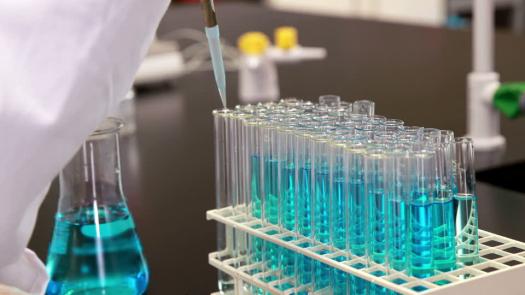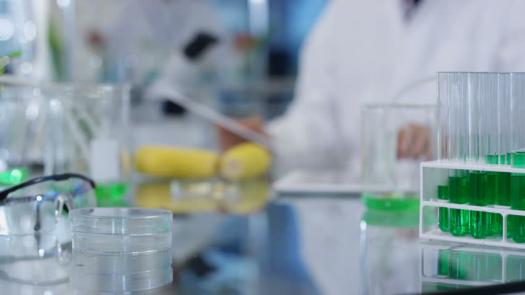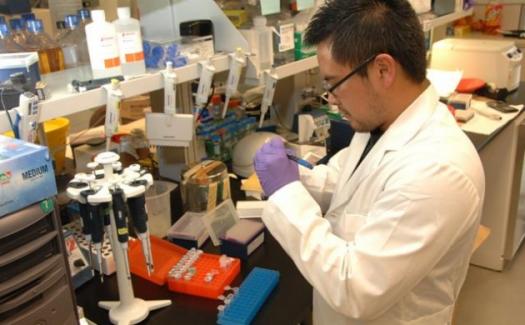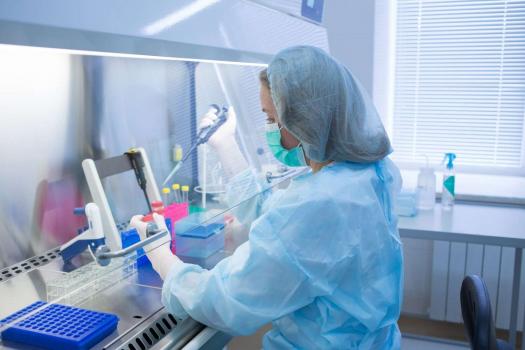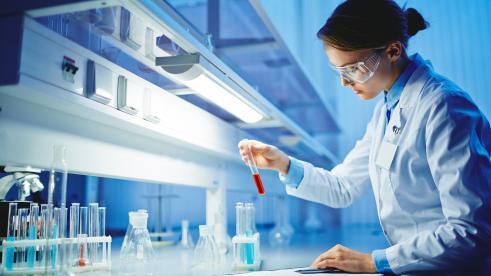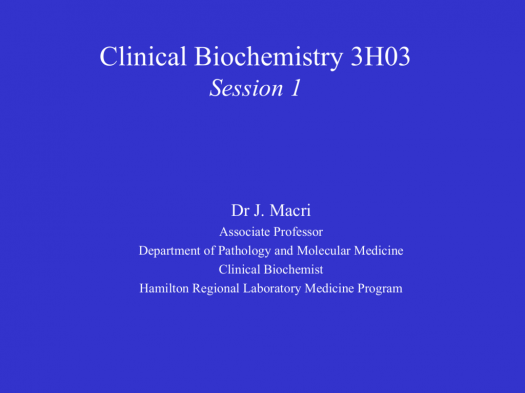Can You Pass This Clinical Biochemistry Test? Trivia Quiz

Clinical Biochemistry is the division of laboratory medicine that deals with the measurement of both natural and unnatural chemicals in blood, urine and other several body fluids. These test results are very useful for diagnosing health problems, determining prognosis and properly guiding the therapy of a patient. This short quiz is to test your knowledge regarding this aspect of medical importance.
- 1.
Each transferrin molecule has how many binding sites for the ferric cation?
- A.
5
- B.
3
- C.
2
- D.
7
Correct Answer
C. 2Explanation
Transferrin is a protein that transports iron in the blood. Each transferrin molecule has two binding sites for the ferric cation, allowing it to bind and transport two iron ions at a time. This enables efficient iron transport throughout the body.Rate this question:
-
- 2.
Where does the remaining haemoglobin circulate when the haptoglobin capacity to bind haemoglobin is exhausted?
- A.
Liver
- B.
Kidney
- C.
Plasma
- D.
Stomach
Correct Answer
C. PlasmaExplanation
When the haptoglobin capacity to bind hemoglobin is exhausted, the remaining hemoglobin circulates in the plasma. Haptoglobin is a protein in the blood that binds to free hemoglobin released from red blood cells. It prevents the hemoglobin from causing damage to the kidneys and helps in its removal from the bloodstream. However, when the haptoglobin capacity is overwhelmed, the unbound hemoglobin remains in the plasma, potentially leading to kidney damage and other complications.Rate this question:
-
- 3.
Which of the following is a glycoprotein which has a molecular weight of 340 kDa?
- A.
Beta-Lipoprotein
- B.
Haemopexin
- C.
Immunoglobulins
- D.
Fibrinogen
Correct Answer
D. FibrinogenExplanation
Fibrinogen is a glycoprotein with a molecular weight of 340 kDa. Glycoproteins are proteins that have carbohydrates attached to them, and fibrinogen is one such example. It plays a crucial role in blood clotting, as it is converted into fibrin during the clotting process. Fibrinogen is produced by the liver and circulates in the blood, and its presence is necessary for the formation of stable blood clots. Therefore, among the given options, fibrinogen is the correct answer.Rate this question:
-
- 4.
There are how many types of cryoglobulin?
- A.
2
- B.
3
- C.
5
- D.
4
Correct Answer
B. 3Explanation
There are three types of cryoglobulin.Rate this question:
-
- 5.
Which of the following refers to proteins whose concentration in the plasma alters in an acute inflammatory involvement?
- A.
Acute Phase Reactants
- B.
Polyclonal Acute Gammopathy
- C.
Acute Gamma Globulins
- D.
C-Reactive Protein
Correct Answer
A. Acute Phase ReactantsExplanation
Acute Phase Reactants refer to proteins whose concentration in the plasma alters during acute inflammatory involvement. These proteins are synthesized by the liver in response to inflammation and play a crucial role in the body's immune response. They include C-reactive protein, fibrinogen, and serum amyloid A, among others. Monitoring the levels of acute phase reactants can help in diagnosing and assessing the severity of inflammatory conditions.Rate this question:
-
- 6.
Which of the following has a total MW of 220,000 - 235,000?
- A.
Procalcitonin
- B.
Serum Amyloid
- C.
Ferritin
- D.
Cytokines
Correct Answer
B. Serum AmyloidExplanation
The correct answer is Serum Amyloid. Serum Amyloid has a total MW (molecular weight) that falls within the range of 220,000 - 235,000. Procalcitonin, Ferritin, and Cytokines do not have a total MW within this range.Rate this question:
-
- 7.
What's the major extracellular cation?
- A.
Sodium
- B.
Water
- C.
Ammino acids
- D.
Substrates
Correct Answer
A. SodiumExplanation
Sodium is the major extracellular cation because it is found in higher concentrations outside the cells compared to inside the cells. It plays a crucial role in maintaining fluid balance, transmitting nerve impulses, and regulating muscle contractions. Sodium is also important for maintaining blood pressure and pH levels in the body.Rate this question:
-
- 8.
Sodium is primarily excreted through which of the following?
- A.
Skin
- B.
Kidney
- C.
Anus
- D.
Urine
Correct Answer
B. KidneyExplanation
Sodium is primarily excreted through the kidneys. The kidneys play a crucial role in maintaining the body's electrolyte balance, including the levels of sodium. They filter the blood and remove excess sodium, which is then excreted in the urine. The skin also plays a minor role in sodium excretion through sweat, but the majority of sodium is eliminated through the kidneys. The anus is not involved in sodium excretion.Rate this question:
-
- 9.
Hypokalaemia may cause which of the following?
- A.
Muscular weakness
- B.
Lack of muscle growth
- C.
Faster nerve impulse propagation
- D.
Extrarenal pure water losses
Correct Answer
A. Muscular weaknessExplanation
Hypokalaemia is a condition characterized by low levels of potassium in the blood. Potassium is essential for proper muscle function, and when levels are low, it can lead to muscular weakness. This weakness can manifest as fatigue, cramps, and difficulty in performing physical activities. Therefore, hypokalaemia can cause muscular weakness.Rate this question:
-
- 10.
The distribution space of Chloride Anion corresponds to how many percent of body weight?
- A.
20%
- B.
30%
- C.
50%
- D.
10%
Correct Answer
A. 20%Explanation
The distribution space of Chloride Anion corresponds to 20% of body weight. This means that approximately 20% of the body's total weight is made up of chloride anions.Rate this question:
-
Quiz Review Timeline +
Our quizzes are rigorously reviewed, monitored and continuously updated by our expert board to maintain accuracy, relevance, and timeliness.
-
Current Version
-
Mar 22, 2023Quiz Edited by
ProProfs Editorial Team -
Jun 19, 2019Quiz Created by
AdewumiKoju
- Aeronautics Quizzes
- Aerospace Quizzes
- Agricultural Science Quizzes
- Astrology Quizzes
- Astronomy Quizzes
- Atom Quizzes
- Biology Quizzes
- Biomechanics Quizzes
- Biostatistics Quizzes
- Biotechnology Quizzes
- Botany Quizzes
- Branches Of Science Quizzes
- Cytology Quizzes
- Easy Science Quizzes
- Ecology Quizzes
- Electrical Quizzes
- Embryology Quizzes
- Endocrinology Quizzes
- Engineering Quizzes
- Environmental Science Quizzes
- Epidemiology Quizzes
- Experiment Quizzes
- Forestry Quizzes
- Fossil Quizzes
- Gas Quizzes
- General Science Quizzes
- Genetics Quizzes
- Histology Quizzes
- Human Biology Quizzes
- Integrated Science Quizzes
- Invention Quizzes
- Library Science Quizzes
- Lighting Quizzes
- Liquid Quizzes
- Marine Biology Quizzes
- Microbiology Quizzes
- Nature Quizzes
- Neuroscience Quizzes
- Nuclear Science Quizzes
- Oceanography Quizzes
- Physics Quizzes
- Psychology Quizzes
- Science And Technology Quizzes
- Science Glossary Quizzes
- Science Knowledge Quizzes
- Science Practice Quizzes
- Scientific Method Quizzes
- Scientific Notation Quizzes
- Soil Science Quizzes
- Solar System Quizzes
- Solid Quizzes
- Zoology Quizzes
 Back to top
Back to top




